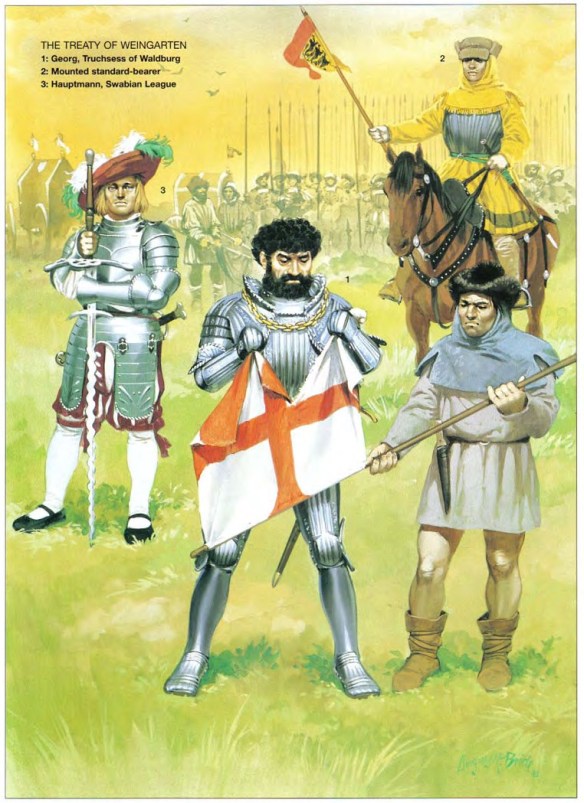
The headquarters of the League was based in Ulm. Here supreme command was exercised through a war council. which prescribed the various contingents of troops to be levied from each member. Thus with every new applicant the League’s military capability would theoretically increase. Contemporary documents give a snapshot of the standing contingents drawn up by the Council.
The League still relied on the heavy armoured cavalry of the nobility, although the effectiveness of Swiss pikemen during the Swabian Wars of 1498-99 had ushered in a new era in military tactic; in which the supremacy of the mounted knight had been placed into question. Indeed, the Peasants’ War occurred at a time when the deployment of squared pike formations with wings of hand gunners was in the ascendancy. If horse was to be effective then it needed to be mobile, and if heavy armoured horse was to be effective then it would need both an element of surprise and an opposing infantry force which was not well endowed with pikes. The League’s mobile horse was known as the ‘Rennfahne’- a light cavalry vanguard, identified by the standard of two crossed red swords on a black and white standard. In putting together mounted contingents, the independent cities and town not under the authority of the regional princes drew heavily on ‘poor knights’- sons of the lower and impoverished nobility. who had no inheritance or social role and hence were often found roaming the countryside as robber knights. Because they were likely to be of no fixed abode and therefore could not afford too costly and weighty horse amour, it is more probable that such freelancers rode in the vanguard where more mobile horse were preferred.
The League foot was drawn from the ranks of the many Landsknechts – mercenary foot soldiers, who offered their services for a monthly wage of 4 guilders. They were organised in regiments or Haufen. which in tum consisted of companies or Fähnlein numbering between 120 and 300 men. Each Fähnlein was so-called because it was identified by its own banner, Fahne. Banners in the League ranks would often be those belonging to the towns and Imperial Cities, which raised mercenaries as part of their contribution to the League army. Each company was composed of smaller sub-units, the basic squad of about ten men being known as a Rotte.
Because each Landsknecht had to clothe, arm and feed himself, such mercenary armies were always accompanied by a substantial train or Truss of sutlers and prostitutes, which itself required some organisation and discipline if it was not to hamper the troops; hence this too acquired its own command structure. Alongside the regimental organisation, the Landsknechts maintained their own informal structure symbolised by the ‘ring’ or general assembly known as the Gemein, and their own court martial presided over by an officer known as the Schultheiss, with the task of policing the ranks given to an officer known as the Provost.
Towards the end of 1524 the League resolved to maintain a small contingent of 200 horse and foot divided between the cities of Vim and Kempten to deal with any further peasant disturbances. By the turn of 1525, however, the uprisings in the Black Forest, Breisgau, Hegau, Sundgau and Alsace demanded a substantial muster, and 3,000 foot and 300 horse were raised. Leonard V of Eck, the Chancellor of Bavaria and a leading figure in the League’s Council, was keen to move aggressively against the peasants. The League army was stretched, however, since the Archduke Ferdinand was concerned with incursions mounted by Ulrich, the exiled Duke of Wurttemberg intent on reclaiming his duchy. Given that substantial numbers of mercenaries had crossed the Alps to serve with Georg von Frundsberg in the Italian Wars, the League was faced with a problem in raising a sufficiently sizeable force to put down the peasant revolts.
Strategically it was going to be necessary to buy time. This could only be done by engaging in token negotiations with the peasants over their political demands, in the hope that the League army could be reinforced once Frundsberg’s men had returned from Italy. The task of commanding the League army was given to Georg, Truchsess (governor) of Waldburg, who resided in the Allgau-one of the centres of the disturbances. When he began his campaign at the beginning of April he had an army of 1,500 horse and 7,000 infantry and 18 artillery pieces. The Truchsess appointed Frowin von Hutten as his lieutenant in charge of horse, and Duke Wilhelm von Furstenberg to command the foot.